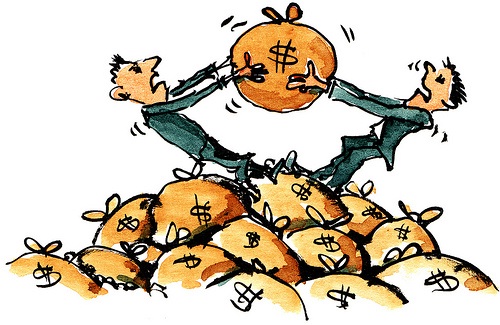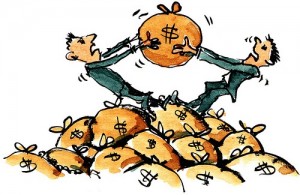
eBook Price Strategy on Amazon
Now your book is ready and about to be put on Amazon shelves. Yet, one question remains. What is the ideal price? Luckily, Fingers Murphy has kindly authorized the republication of his post about his own strategy and observations.
eBook Price Clustering: Does the Price of Your Book Define Who Will Buy It?
First published by Fingers Murphy
Does the price you set your book at dictate which “Customers Also Bought” lists it ends up on? I think it does. This may be an obvious function of buyers having certain traits. Those looking for bargain books buy bargain books, those willing to pay full price are more likely to pay full price. But I think the ramifications are something indie authors need to consider. I offer my own two books as anecdotal examples.
I published FOLLOW THE MONEY in May and, after a slow start, I reduced it from $2.99 down to $.99 in the hope that sales would jump. As I’ve remarked before, sales grew, but not spectacularly. Rather, it has been a slow, steady buildup, and I suspect that buildup would have occurred at the higher price point. But I had no ability to test that theory.
So, when I put THE FLAMING MOTEL out at the end of August, I decided I would put it at $2.99 and leave it there. I also moved FOLLOW THE MONEY back to $2.99. It’s early yet, but I’ve noticed something interesting about the books showing up in the Customer Also Bought lists for the two books.
First of all, it’s important to understand what Customer Also Bought lists are and why they matter. Next to Amazon affirmatively promoting a title, I think these lists are the single biggest driver of sales. I don’t fully understand how they work, but they seem to define a universe of books that are commonly bought by the same readers. The more commonly they are bought by the same readers, the earlier they show up in the Customers Also Bought list.
For example, Steven J. Harper’s THE PARTNERSHIP is the first book on the Also Bought list for FOLLOW THE MONEY. I don’t know this for a fact, but I suspect that more readers of FOLLOW THE MONEY have also bought THE PARTNERSHIP than any other book. If you click on THE PARTNERSHIP and scroll through its Also Bought list, FOLLOW THE MONEY is the eleventh recommendation. Which makes sense because THE PARTNERSHIP has been a very successful book, so lots of people have bought it (and bought ten other books more often than mine). Obviously, the higher up your book is on another book’s Also Bought list, the more likely readers are to see it and click on it. And these are very valuable clicks because they are typically readers who are already interested in books very similar to yours (or at least often bought by people with a certain collection of tastes). The more popular the book is, the more referrals your book will get. These are very valuable referrals.
However, once your book gets clustered together with a certain group of books, it gets harder and harder to break out of that universe. Does this matter? In think it might matter a lot. Let’s look at my books.
FOLLOW THE MONEY spent the entire summer at $.99. Of its 100 Customer Also Bought recommendations, 48 are other $.99 books. Basically, half of the other books that show up as recommendations (and in whose Also Bought lists FOLLOW THE MONEY shows up) are $.99 books. Meaning at least half of the people who come across FOLLOW THE MONEY because of Amazon’s suggestion will be people who are looking at $.99 books. The high concentration of $.99 recommendations suggests to me that there are a lot of bargain shoppers out there who are buying only, or mostly, $.99 books. This causes a problem if, like me, you want to raise your price. Will all those people who are looking for $.99 bargains who come across my book be willing to buy it at a higher price? Or will they dismiss it out of hand because of the price? Time will tell.
THE FLAMING MOTEL, which is just two weeks into its release, has only 17 Also Bought recommendations so far. But interestingly, only one of those books is a $.99 title (Ken Isaacson’s SILENT COUNSEL). The rest are all $2.99 and up, and half of them are over $5. This suggests that THE FLAMING MOTEL is being bought by a completely different group of readers and is not being snapped up by the $.99 bargain hunters. It also suggests that if I raised the price to $3.99 or $4.99, the people who are buying it wouldn’t necessarily have a problem with it because they’re used to paying that much and more.
This is important for an indie writer’s long term strategy because there appears to be real stratification between bargain hunters and the rest of the book buyers out there. Those willing to pay more generally do pay more, and those who want to pay $.99 tend to mostly pay only $.99.
At first, a new indie writer wants readers, and will take them at any price. The $.99 price point makes sense in that circumstance. But the reader you may be attracting, and who may end up defining where you book gets “recommended” by Amazon’s Also Bought lists, may trap you in the $.99 ghetto. This could make it very difficult to raise the price once the book gains some traction because the $.99 crowd may resist paying anything above that.
This is a basic branding question. What kind of product are you selling? A bargain product, a mid-range one, or a high-end premium product? Once something gets defined one way, it’s hard to change its perception. The Amazon Customers Also Bought list ensures that your book has an established perception, which is a great thing. But you should at least have a plan for managing that perception over time.
Even at $2.99 a book is still on the low, self-published end of the spectrum. It’s just not a lot of money for something that should provide hours of highly engaged entertainment. Over the long haul, it might be better to build your audience more slowly at a higher price than to get defined (perhaps permanently) at the $.99 price point where customers may be very resistant to any price increases.
More Data on eBook Price Clusters and Amazon’s Customers Also Bought Lists
First published by Fingers Murphy
I wrote a couple of weeks ago about the effect that ebook pricing has on Amazon’s Customers Also Bought lists. I had listed my new book, THE FLAMING MOTEL (UK), at $2.99 after having my first book, FOLLOW THE MONEY , at $.99 through the whole summer. What I’d noticed was that Amazon’s Customers Also Bought list for my new book was populating with higher priced books than the Also Bought list for my book that had been listed at $.99.

FOLLOW THE MONEY has held pretty steady, despite the fact that it has now been back at $2.99 for about a month. It currently has 46 of its 100 suggestions at the $.99 level. Virtually no change from the 48/100 it had two weeks ago.
THE FLAMING MOTEL now has 11 out of its 50 suggestions priced at $.99. Although this is a significant increase from where it was in the last post, it is still substantially below the level of FOLLOW THE MONEY: 22% versus 48%. The difference seems meaningful to me.
What does all of this mean as a practical matter? I think it means that, to the extent Amazon’s system makes associations between your book and other books based on who bought your book and other books, the price has a large effect on the company you keep. Once associated with $.99 books, the association is hard to break. That could have longer term effects.
Most importantly, it might make it much more difficult to raise prices. I raised FOLLOW THE MONEY to $2.99 and the book continues to sell about as well as it did as a $.99 book, but $2.99 is still a bargain book. Query whether it would continue to sell if I raised it to $3.99 or $4.99. Would all of those people looking at $.99 books who saw mine in the Also Bought lists be willing to pay such a “premium?”
If you look at THE FLAMING MOTEL, the books in its Also Bought list are much more expensive, with many mainstream books. It seems that those buyers would tolerate such a price increase pretty easily. I’m going to let a few months of data accumulate and see if the trend holds. Then I may try some pricing experiments.

